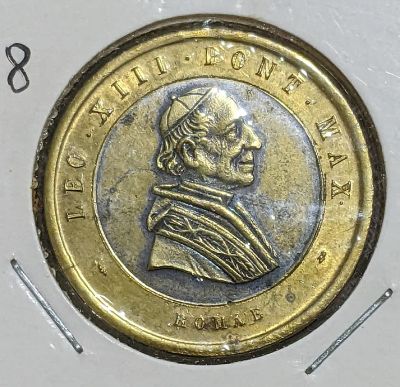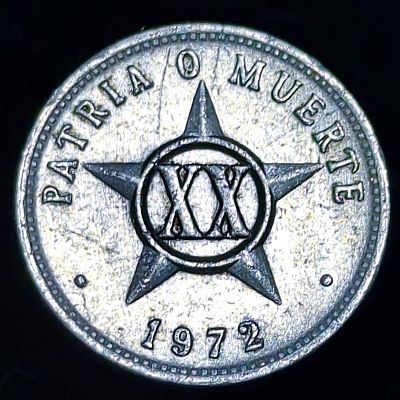A year in very long Roman Numerals

When covering the medallions of the popes between the last Papal States coins, and the first Vatican City coins, I was tempted to include this one, but I thought it deserved its own post.
I’ve seen variations of this medallion listed in several places and apparently in several different metals, from Bronze to a silver coloured metal, but mine appears to be either bimetallic, or to be brass with a coated inner section. I really like this portrait of Pope Leo XIII, it looks like a more “natural” image than you often see – his face isn’t completely smooth and his hair isn’t perfectly neat; he looks human.
As head of the Catholic church from 1878 until his death in 1903, he reigned in that period between the Papal States and Vatican City. He was called the Pope of the workers for his 1891 Encyclical on the rights of workers. Serving until the age of 93 he was the oldest Pope until Benedict XVI, and had the fourth longest Papal reign.

One interesting aspect of this piece, and the reason I wanted to share it on its own, is the year. It was issued for the 50th Anniversary of the Ordination of Pope Leo XIII, 1888. The year is included on the piece in Roman Numerals: MDCCCLXXXVIII. At 13 letters, it is the longest year to date in Roman Numerals. The longest year coming up will be 3888, at 15 letters. The next longest will be 2888, at 14 letters. If you can’t wait that long, 2088 is the longest this century at 10 letters).
A quick recap of Roman Numerals:
I = 1
V = 5
X = 10
L = 50
C = 100
D = 500
M = 1000
So MDCCCLXXXVIII is 1000 + 500 + (3 x 100) + 50 + (3 x 10) + 5 + (3 x 1).
The shortest year in Roman Numerals since the year 1000 (M) was the millennium – MM. There were 19 coins issued with that date as MM (that I found on Numista, anyway). And in keeping with the theme of this post, here is a medal with Roman Numerals for that year:

Looking for more patterns, using each roman numeral backwards: MDCLXVI was the year 1666. If that sounds like an unlucky number, then Numisa offers 13 coins with MDCLXVI on them. All of those are from German States (one from Trier and 12 from Brunswick-Wolfenbüttel).
2022 was a bit of a pattern in Roman numerals: MMXXII. Numista lists 25 coins (all non-circulating) with that number, and I don’t have any of those myself. If you do, and would like to share a picture with me, I’d be happy to add it with a link to you!
Those all being non-circulating got me thinking – what was the last circulating coin with Roman numerals? Here are two answers:

This Cuban 20 Centavos has the value, 20 or XX, written in Roman Numerals. My example is from 1972, however this coin has continued to be issued with the same design. Numista lists it as produced at least until 2021.
That coin has the value in Roman numerals, but the year isn’t. For the year in Roman numerals, the most recent coin I can find is 2018 Portugal 2 Euro National Mint commemorative. I don’t have that one myself, so here is the photo from Numista:

Since we’re talking about Roman Numerals, here is an interesting piece. I thought I had a reasonable general grasp of how Roman Numerals worked until I picked up this Queensland Government Railways piece. It is commemorating “$ CCCCCCIↃↃↃↃↃↃ revenue” for the 1969 – 1970 financial year:

I had to go hunting around to decipher this one. It turns out that there were several different schools of thought on how to write really large numbers in Roman Numerals.
In the vinculum system you placed an overline above a standard Roman numeral string to indicate that the entire string was to be multiplied by 1000, and further added a leading and following vertical line to indicate it was to be multiplied by 100,000.
In the apostrophus system, you have pairs of C and Ↄ around a central I. Starting at 1,000, each pair is a power of 10. So CIↃ is 1,000, CCIↃↃ is 10,000, CCCIↃↃↃ is 100,000 and so on. With six C either side of the I, QGR made $100 Million dollars that year.
What is your favourite coin or medal with a Roman numeral on it? Or your favourite Roman numeral pattern on a coin or medallion?


Leave a Reply